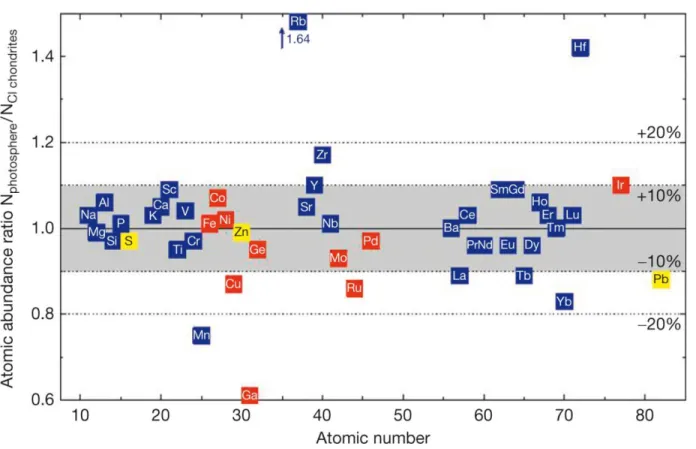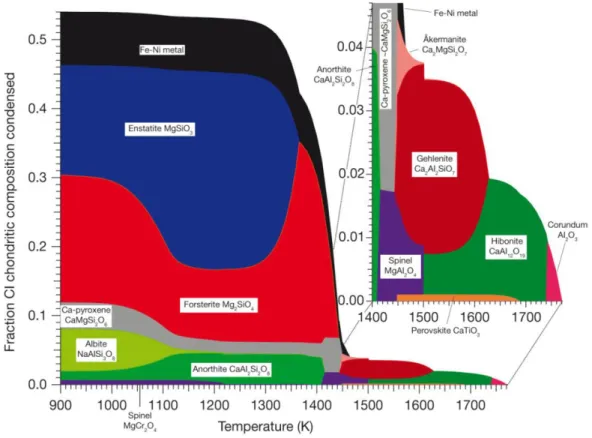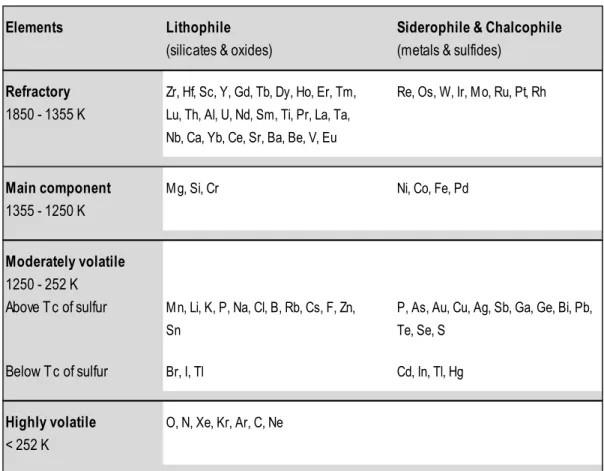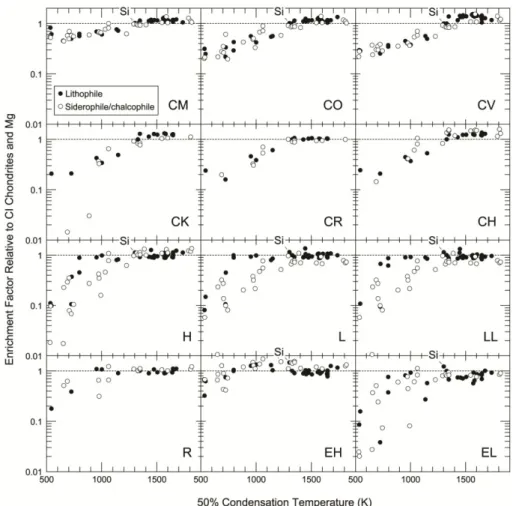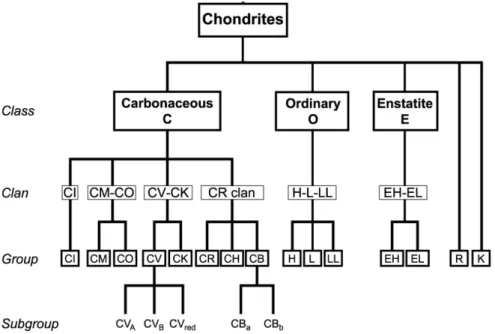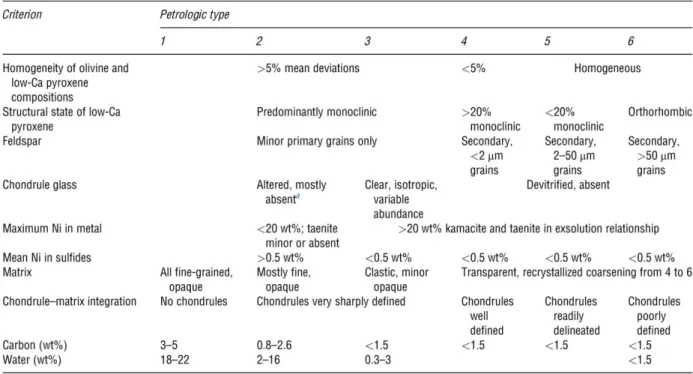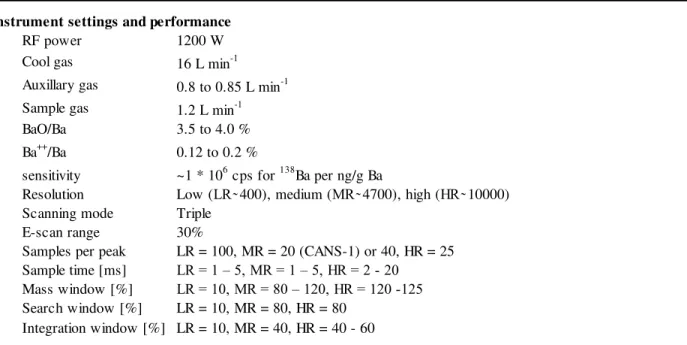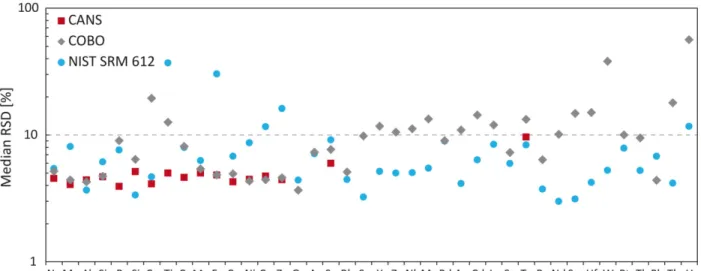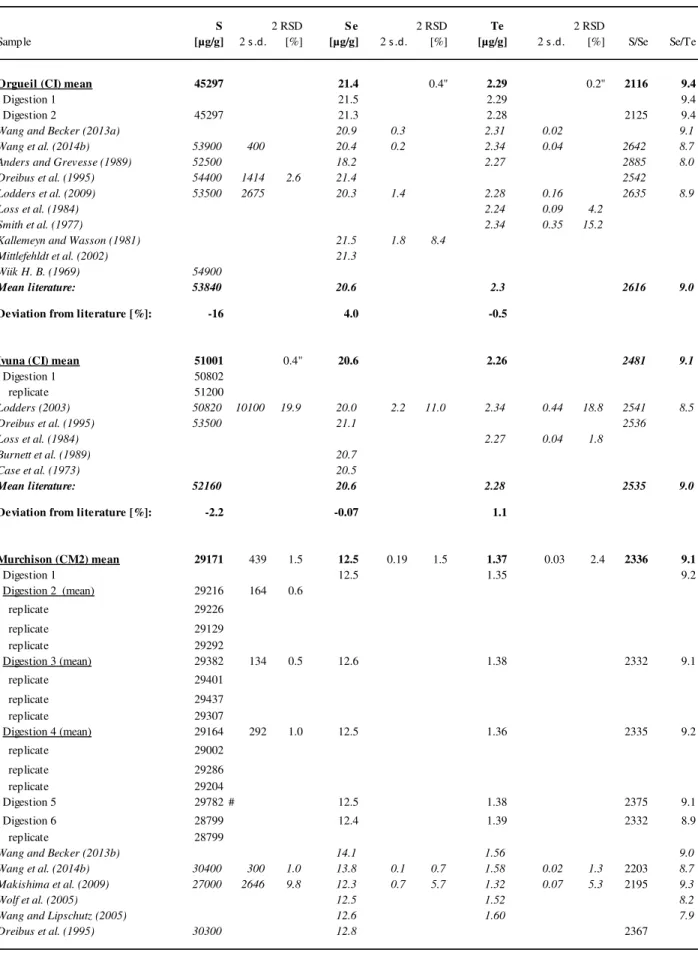Abundances and distribution of chalcogen volatile elements in chondritic meteorites and their components
Inaugural-Dissertation zur
Erlangung des Doktorgrades
der Mathematisch-Naturwissenschaftlichen Fakultät der Universität zu Köln
vorgelegt von
Claudia Funk
aus Hagenow
Köln, 2015
Berichterstatter: Prof. Dr. Carsten Münker (Gutachter)
PD Dr. Dominik Hezel
Tag der mündlichen Prüfung: 8. Mai 2015
„0 ist Nichts & Alles ist 1“ Thomas. R. Pennington
Abstract ... 1
Kurzzusammenfassung ... 3
1. Introduction 1.1. The origin of the elements ... 7
1.2. Solar system abundance of the elements ... 9
1.3. CI chondrites ... 10
1.4. Cosmochemical classification of the elements ... 12
1.5. Primary element fractionation ... 15
1.6. Chondritic components ... 19
1.7. Primary classification of chondrites ... 22
1.8. Secondary and tertiary classification parameters ... 24
2. Quantification of novel calibration and reference materials for LA-ICP-MS analysis 2.1. INTRODUCTION ... 28
2.2. SAMPLE AND CALIBRATION MATERIALS ... 29
2.3. EXPERIMENTAL – QUANTIFICATION OF CANS AND COBO ... 30
2.3.1. Solution nebulization SF-ICP-MS and ICP-OES ... 30
2.3.2. Isotope dilution ICP-MS analysis of S, Se and Te... 37
2.3.3. Additional analysis by Q-ICP-MS, EMS, INAA, XRF, and Karl Fischer titration ... 39
2.4. RESULTS AND DISCUSSION ... 40
2.4.1. Composition of CANS ... 40
2.4.2. Composition of COBO ... 45
3.1. INTRODUCTION ... 51
3.2. EXPERIMENTAL ... 53
3.2.1. Femtosecond LA-ICP-MS ... 53
3.2.2. Data treatment and ablation yield correction ... 54
3.3. RESULTS AND DISCUSSION ... 57
3.3.1. Homogeneity of CANS, COBO, and NIST SRM 612 ... 57
3.3.2. Comparison of ablation yields for NIST SRM 612, CANS and COBO ... 59
3.3.3. Evaluation by 100% sum standardization with external CANS-NIST calibration using COBO as a test sample ... 63
3.4. CONCLUSION ... 64
4. Sulfur, selenium, and tellurium abundances and distributions in chondrites And their components 4.1. INTRODUCTION ... 67
4.2. ANALYTICAL METHODS ... 69
4.2.1. Isotope dilution ICP-MS analysis of S, Se and Te ... 69
4.2.2. Femtosecond laser ablation ICP-MS analysis ... 72
4.3. RESULTS ... 73
4.3.1. Reproducibility and accuracy ... 73
4.3.2. Sulfur, selenium and tellurium concentrations in bulk chondrites ... 81
4.3.3. Abundances and distribution of S, Se and Te in chondritic components ... 86
4.4. DISCUSSION ... 96
4.4.1. Primary (pre-accretionary) depletion during chondrule formation ... 96
4.4.2. Decoupling of Te during chondrule formation ... 99
4.4.3. Secondary depletion - Redistribution of Te on the parent body ... 100
4.4.4. Aqueous alteration ... 101
4.4.5. Sample heterogeneity ... 102
4.4.6. Comparison of chondritic ratios with the Earth ... 102
4.6 CONCLUSION ... 103
6. Danksagung ... 125 7. Erklärung ... 127 8. Lebenslauf ... 128
1 The Sun comprises approximately 99.8 % of the matter of the solar system. Thus, the chemical composition of the Sun is considered representative for the composition of the solar system in cosmochemistry. Based on spectroscopic studies of the solar photosphere and chemical investigations on meteorites, the composition of the solar system is now relatively well known.
There is one group of meteorites – the CI chondrites – that are of special interest as their composition is nearly indistinguishable from the composition of the solar photosphere for non- atmophile elements. Thus, the composition of CI chondrites is broadly used for reference purposes in cosmochemistry. Compared to CI chondrites all other inner solar system materials are depleted in volatile elements. The reasons for this pervasive primary depletion of volatile elements are still under debate.
Chondritic meteorites contain the most pristine solar system materials available for scientific investigations. They consist of different components such as chondrules (small melt droplets), refractory inclusions (e.g. Ca, Al-rich inclusions), metals, and sulfides embedded in fine-grained matrix material. Some of these components are thought to have formed under different spatio- temporal conditions (e.g. Chondrules and CAIs) before they assembled to form the chondrite parent bodies. After accretion, processes such as thermal metamorphism, aqueous alteration, and shock metamorphism during collisions may have further changed the chemical composition of chondritic material. Investigations on chondrites that largely escaped such secondary processes yield information about the pre-accretionary processes that were involved in the primary depletion of volatile elements in the early solar system. To better understand these processes the focus of this work was on the development and utilization of novel analytical methods to study the elemental abundances in chondritic components and in bulk chondrites. A special focus was on the chalcogen and moderately volatile elements sulfur, selenium and tellurium.
The first chapter of this dissertation contains a general introduction to the topic. Chapter 2 comprises the analytical protocols of all methods that were applied within this thesis. These methods were utilized for the quantification of major-, minor-, and trace elements in two novel reference materials developed for laser ablation inductively coupled plasma mass spectrometry
2 trace element concentrations by sector field ICP-MS in “synthetic” and natural chondritic reference materials matrix-matched calibration solutions were developed and prepared. An isotope dilution ICP-MS method for the highly precise and accurate determination of Se and Te concentrations was refined and adjusted to chondrites, while a second isotope dilution ICP-MS method to determine S concentrations in bulk chondrites was set up completely new. Both methods are now routinely implemented and allow the determination of accurate and precise S, Se and Te concentrations from the same sample aliquot.
Chapter 3 comprises the analytical approach to determine the abundances and distributions of elements in chondritic components using femtosecond LA-ICP-MS. The focus was on the elaborative quantification of elements in chemically and physically heterogeneous and thus challenging chondritic matter. Because common procedures to correct for different ablation yields between sample and external calibration material failed, an alternative strategy was applied. However, this strategy in which the ablation yield is corrected by the total material requires a suitable external calibration material for major and minor element calibration in chondrites. According to this, matrix-matched calibration and reference materials (based on synthetic and natural nano-particles) were designed, prepared, quantified (Chapter 2) and applied (Chapter 4) during this PhD project. This chapter thus contains the application and applicability of the novel reference materials as well as the analytical setup and the strategy for data evaluation.
In Chapter 4 highly precise and accurate isotope dilution ICP-MS concentration data for S, Se, and Te in 54 chondrites of different classes and groups of carbonaceous, ordinary, enstatite, and Rumuruti chondrites are presented. Furthermore, this chapter presents the first data obtained from the newly developed femtosecond LA-ICP-MS method described in Chapter 3. In-situ laser ablation ICP-MS data yield information about the distribution and the relative abundances of S, Se and Te in sulfides and metals in different chondritic components such as chondrules, matrix, and refractory inclusions. Initial results indicate that S, Se, and Te depletion and in particular the decoupling of Te from Se in ordinary chondrites might be related to chondrule formation. It is demonstrated that bulk analyses are instructively complemented by the in-situ LA-ICP-MS analysis.
3 Da die Sonne mit ~99.8 % den Hauptteil der Materie unseres gesamten Sonnensystems umfasst wird die chemische Zusammensetzung der Sonne in der Kosmochemie mit der chemische Zusammensetzung unseres Sonnensystems gleichgesetzt. Mit Hilfe spektroskopischer Untersuchungen der Photosphäre der Sonne und chemischer Untersuchungen an Meteoriten sind die Häufigkeiten der meisten Elemente des Sonnensystems mittlerweile relativ gut bekannt. CI Chondriten kommt dabei eine besondere Rolle zu, da die relative Häufigkeit für fast alle non- volatilen Elemente in CI Chondriten nahezu identisch ist mit denen der solaren Photosphäre.
Aufgrund dessen wird die chemische Zusammensetzung dieser Meteorite in der Kosmochemie als Referenz benutzt. Im Vergleich zu CI Chondriten sind alle anderen Materialien des inneren Sonnensystems an kosmochemisch flüchtigen Elementen wie K, Zn oder S verarmt. Die Prozesse die zur primären Verarmung flüchtiger Elemente geführt haben sind noch nicht endgültig geklärt.
CI und andere chondritische Meteorite sind das ursprünglichste Material des inneren Sonnensystems, welches für Laboruntersuchungen zur Verfügung steht. Sie bestehen aus unterschiedlichen Komponenten wie Chondren (kleine Schmelzkügelchen), und refraktären Einschlüssen (z. B. Ca, Al-reiche Einschlüsse), Metallen und Sulfiden, eingebettet in feinkörnigem Matrixmaterial. Einige dieser Komponenten sind zeitlich und/-oder räumlich unabhängig voneinander entstanden (z. B. Chondren und CAIs) bevor sie sich gemeinsam zu Mutterkörpern zusammengefügt haben. Nach der Akkretion können weitere Prozesse wie thermische Metamorphose und wässrige Alteration auf dem Mutterkörper oder auch Schockmetamorphose aufgrund von Kollisionen die chemische Zusammensetzung verändert haben. Betrachtet man jedoch die Chondrite und deren Komponenten die durch solche sekundären Prozesse weitgehend verschont geblieben sind, erhält man Informationen über die prä-akkretionären Prozesse die an der Verarmung flüchtiger Elemente im frühen inneren Sonnensystem beteiligt waren. Um diese Prozesse besser zu verstehen wurden in dieser Arbeit gezielt neue analytische Methoden zur Untersuchung der Elementhäufigkeiten in chondritischen Komponenten und in gesamtchondritischem Material entwickelt und angewendet. Ein besonderer Focus lag dabei auf den chalcogenen, moderat flüchtigen Elementen Schwefel, Selen und Tellur.
4 Kapitel in Verbindung mit der Quantifizierung von Haupt-, Neben-, und Spurenelementen zweier neu entwickelter Referenzmaterialien für die Laserablations ICP-MS (induktiv gekoppelte Plasma Massenspektrometrie) angewendet wurden. Somit enthält dieses Kapitel auch die für diese Referenzmaterialien ermittelten Referenzwerte und deren Bewertung. Für die Bestimmung der Haupt-, Neben-, und Spurenelemente mittels Sektorfeld-ICP-MS in „synthetischen“ und natürlichen chondritischen Referenzmaterialien wurden matrixangepasste Kalibrierlösungen entwickelt und hergestellt. Die Isotopenverdünnungs-ICP-MS Methoden für die präzise und akkurate Bestimmung der Gesamtkonzentration an Schwefel, Selen und Tellur in Chondriten wurden für Se und Te verfeinert und an chondritisches Material angepasst und für S neu aufgesetzt. Beide Messverfahren wurden als Routinemethoden etabliert.
In Kapitel 3 wird die Herangehensweise zur Bestimmung der Konzentration und Verteilung von Elementen in chondritischen Komponenten per Femtosekunden-, Laserablations-ICP- Massenspektrometrie (LA-ICP-MS) dargelegt. Da die komplexe chemische und physikalische Beschaffenheit von chondritischem Material gewöhnliche Verfahren zur Korrektur unterschiedlicher Ablationsraten zwischen externem Kalibrierungsmaterial und Probe schwer möglich macht, wurde ein alternatives Korrekturverfahren angewendet bei dem die vorherige Bestimmung der Konzentration für ein internes Standardelement durch externe Verfahren (z. B.
Elektronenstrahlmikrosonde) nicht erforderlich ist. Der Korrekturfaktor für die unterschiedlichen Ablationsraten wird hier über die Summe der Haupt- und Nebenelemente berechnet, welche hierfür per Laserablations ICP-MS mitgemessen werden. Zur externen Kalibrierung der Haupt- und Nebenelemente wurde eine matrixangepasste Pulverpresstablette aus Nanopartikeln hergestellt, welche diese Elemente etwa in CI-chondritischer Häufigkeit enthält. Eine weitere Presstablette wurde für die Qualitätskontrolle aus dem CM2 Chondriten Cold Bokkeveld hergestellt und auf die Anwendbarkeit als externes Kalibrierungsmaterial getestet. Die Anwendung und Anwendbarkeit der beiden neuen Referenzmaterialien, sowie der analytische Aufbau und die Auswertungsstrategie der Laserdaten sind in diesem Teil der Arbeit abgefasst.
In Kapitel 4 werden die Ergebnisse von hochpräzisen S, Se, und Te Konzentrationsdaten für 54 Gesamtchondrite unterschiedlicher Klassen und Gruppen kohliger, gewöhnlicher, Enstatit-, und Rumurutichondrite aus Isotopenverdünnungs ICP-MS Messungen präsentiert. Des Weiteren
5 Aufschluss über die Verteilung, die Konzentrationen und die relativen Häufigkeiten von S, Se und Te in Sulfiden und Metallen, welche Bestandteil der unterschiedlichen chondritischen Komponenten wie Chondren, Matrix, und refraktäre Einschlüsse sind. Erste Ergebnisse verweisen darauf dass die Verarmung der moderat flüchtigen Elemente S, Se und Te und insbesondere die Entkopplung von Te in gewöhnlichen Chondriten, im Zuge der Chondrenentstehung stattgefunden haben kann. Es wird gezeigt dass die in-situ Analysen an chondritischen Komponenten Informationen hervorbringen die gesamtchondritische Konzentrationsmessungen ergänzen.
7
Chapter 1 INTRODUCTION
1.1 The origin of the elements
The first elements of the Universe (H ~75%, He ~25%, and traces of Li, Be, and B) formed during the “primordial nucleosynthesis” which occurred in the first minutes subsequent to the
„Big Bang“, a massive explosion thought to have formed our universe 13.5 billion years ago.
Elements heavier than hydrogen were primarily produced by stellar nucleosynthesis processes (e.g. Hoyle 1946, 1954; Merrill 1952). With onward cooling and expansion of the universe, the first galaxies including the Milky Way formed within a billion years after the Big Bang by gravitational attraction due to small density variations. Simultaneously, the first stars were formed from a gas of extremely low metallicity, composed almost entirely of H and He. It is assumed that some of these first generation stars (population III stars) must have been extremely massive with >100 solar masses (Mʘ) and formed isolated contemporary to galaxies (e.g. Bromm et al. 1999, 2004; Nakamura & Umemura 2001; Abel et al. 2000, 2002). Due to their extreme mass such stars rapidly exhausted their fuel (within a few million years) and would have exploded in extremely energetic supernovae in which they released most of their mass in the form of heavy elements, the metals. Although low-mass and intermediate-mass stars are far more abundant than high mass stars (>10 Mʘ), the high mass stars have been the primary contributors of heavy elements to the intergalactic and interstellar medium for a long time as their lifetimes are far shorter (a few million years) when compared to the lifetimes of low-mass and intermediate-mass stars, whose lifetimes tend towards billions of years (e.g. McSween & Huss 2010).
Different stages of stars lifetimes cause different processes whereby the extent and the rate of these processes strongly depend on the mass of the star. Hydrogen burning is the initial and longest fusion process in the lifetime of every star. During this stage H is converted into He, in the core of the star until H is exhausted and gravitational collapse occurs due to decreasing radiation pressure. However, the dominating and increasing gravitational compression is
8 accompanied by an increase in core temperatures which can reach those necessary for further nuclear fusion reactions such as helium burning, and in the more massive stars carbon burning, neon burning, oxygen burning, and silicon burning, each of which require higher temperatures for ignition and generate new and more heavy elements up to iron and nickel which have the highest binding energy per nucleon.
The synthesis of elements heavier than iron and nickel requires energy input and are produced by different neutron capture processes (Burbidge et al. 1957; Seeger et al. 1965).
Burbidge et al. (1957) provided the first description of neutron capture processes in stars to generate heavier elements than iron. The general process is driven by the capture of a neutron by a nucleus, increasing the atomic mass by one unit. The resulting nucleus may become a stable isotope of the original element. If it is unstable the atom undergoes β-decay during which a neutron emits an electron, converting to a proton and becoming an isotope of a heavier element.
Depending on the velocity of capture compared to the velocity of decay this process can be subdivided into the slow s-process and the rapid r-process. The s-process occurs during alternate hydrogen-shell and helium-shell burning at low neutron density in the AGB stage of low- and intermediate mass stars where neutron capture is slow when compared to the rate of β-decay. The r-process occurs during supernovae in which heavy seed nuclei are in the presence of neutron flux with extremely high densities. Under these conditions many neutrons can be captured, particularly by unstable nuclei prior to radioactive decay which yielding the potential to generate the heaviest elements up to Uranium. Another process that is able to generate different nuclides or isotopes is irradiation of matter by high-energy particles (e.g. protons and α-particles), in cosmic rays which can originate in the Sun and cause spallation reactions in which a nucleus is split into two or more smaller nuclides. By this, neutrons can be released and captured by other nuclides.
The quantity and composition of the gas in the interstellar medium of a galaxy is generally affected by infalling metal-poor gas, the removal of gas due to star formation and the returning gas enriched in heavy elements from dying stars. Stellar nucleosynthesis changed the initial composition of the gaseous and dusty interstellar medium extensively by enrichment of heavy elements so that the elemental and isotopic composition of next generation stars became increasingly complex (e.g. Ostriker & Gnedin 1996; Bromm et al. 2004; Yoshida et al. 2004).
9 1.2 Solar system abundance of the elements
Because the Sun contains ~99.8 % of the total mass of the solar system the composition of the Sun can be considered as equivalent to the composition of the solar system. The formation of the solar system occurred ~4.57 billion years ago from the gravitational collapse of a part of a molecular cloud, a dense region of the interstellar medium. The elemental abundance of our solar system is primarily inherited from its parent molecular cloud, a mixture of gas and dust composed of elements which originated from nucleosynthesis during the Big Bang, from several generations of massive and intermediate-mass stars that had contributed their material to the interstellar medium by supernovae and novae explosions until the Sun was formed. Knowing the composition of the material from which the solar system was formed helps to understand the evolution of the solar system as well as the chemical and physical processes that produced the different elemental and isotopic compositions of solar system materials. The solar system elemental abundances were mainly determined by spectroscopy of the stellar photosphere and chemical analyses of chondritic meteorites (especially CI chondrites). Indirect information about solar system abundances comes from investigations of comets, interplanetary dust particles, the nearby interstellar medium, hot B stars, and planetary nebulae (e.g. Lodders et al. 2009). Recent compilations for solar system elemental abundances are mainly based on spectroscopic data from the solar photosphere, chemical analyses of CI chondrites (mainly Orgueil) and indirect methods or theoretical considerations to estimate the abundances of elements which cannot be directly measured (e.g. He, Ne, Ar, Kr, Xe). The first comprehensive table of solar system elemental abundances based on compilation of chemical data from terrestrial rocks, meteorites, and individual phases of meteorites was published by Victor Moritz Goldschmidt in 1937. This table also included abundance data of highly volatile elements like C, O, and N, from spectroscopic measurements of the solar photosphere provided by H. N. Russell (1929). Together, these data covered most of the major features of the solar system abundances such as the dominance of H and He, the decrease of element abundance with increasing atomic number, the abundance peak at 56Fe and the low abundance of Li, Be, and B. Additionally, they confirmed the higher abundance of elements with even atomic numbers when compared to elements with odd atomic numbers as discovered by Giuseppe Oddo (1914) and William D. Harkins (1917). The basis of modern tables on elemental abundances of the solar system was given by Suess & Urey in 1956.
10 Their table was based on meteorite data, spectroscopic solar abundances, and theoretical arguments based on a better understanding of nucleosynthesis and nuclear physics. Subsequent element and isotope abundance tables as given by e.g. Anders & Grevesse 1989; Palme & Beer 1993; Grevesse & Sauval 1998; Palme & Jones 2003; Lodders 2003; Lodders et al. 2009; Palme et al. 2014 are permanent updates and refinements of solar and solar system elemental abundances.
1.3 CI chondrites
Carbonaceous chondrites of the Ivuna-type, the CI chondrites represent the most primitive material available for laboratory investigations. Comparisons of the element abundances of CI chondrites and the solar photosphere showed that a large number of elements are present in the same relative abundance in both, the photosphere and in CI chondrites (Figure 1.1). Exceptions are highly volatile elements like H, He, O, C, N, and the noble gases which are depleted in CI chondrites relative to the solar photosphere, whereas Li is depleted in the photosphere due to nuclear burning in the Sun. Even if the elemental abundances of CI chondrites are the most unfractionated relative to the Sun their textures and mineralogy are rather complex. CI chondrites have a brecciated structure, consisting of millimeter to submillimeter sized clasts of different composition, which in turn consist almost entirely of extremely fine-grained hydrous silicates and magnetite. Chondrules and CAIs are absent and high-temperature phases like olivine and pyroxene are extremely rare (Hyman & Rowe 1983; Dodd 1981; Lodders & Fegley 2011).
Furthermore, they are traversed by fractures filled with calcium and magnesium sulfates, as well as carbonates, demonstrating that these meteorites are extensively affected by aqueous alteration on the parent body (Morlok et al. 2006). Currently there are only five known CI chondrites:
Orgueil, Ivuna, Alais, Tonk, and Revelstoke. Because Orgueil is the most massive of the five CI chondrite falls, most abundance data comes from this chondrite. Uncertainties in abundance data can be huge and reflect problems with the sample size, the mobility of some elements as reflected in the chemical heterogeneity within Orgueil, and sample preparation (e.g. Morlok et al. 2006;
Lodders et al. 2009; Palme et al. 2014). As demonstrated by Barrat et al. (2012) Orgueil is chemically homogeneous on the one-gram scale, with the exception of water-soluble elements
11 which are somewhat more variable based on redistribution by fluids on the parent body. On the micrometer scale heterogeneities are much more pronounced (e.g. Morlok et al. 2006).
Figure 1.1 Comparison of photospheric and CI chondritic abundances (Palme et al. 2014). CI chondritic and photospheric abundances agree for 36 elements within ±10%. Lithophile elements are blue, siderophiles red, and chalcophile elements yellow.
12 1.4 Cosmochemical classification of the elements
Almost all inner solar system materials experienced some thermal processing during the evolution of the solar system. Chondrules for example formed during high-temperature events in which precursors were molten, elements evaporated, and partly recondensed. For some other solar system materials like Ca, Al-rich inclusions (e.g. Scott & Krot 2001; Kurat et al., 2002; Lin et al., 2003), amoeboid olivine aggregates (e.g. Krot et al. 2004; Weisberg et al. 2005), metal grains in CB and CH chondrites (e.g. Meibom et al. 2001; Petaev et al. 2001, 2003; Campbell et al. 2001), PGE nuggets, relict hibonite and fassaite in CAIs (e.g. El Goresy et al. 1979, 1984; Lin
& Kimura 2000), relict olivine in chondrules and matrix (e.g. Pack et al. 2004, 2005), it is assumed that they directly condensed from a gaseous phase. Furthermore, bulk chondrites display a smooth fractionation pattern which reflects element abundances in bulk chondrites being strongly controlled by the volatility of these elements. According to these observations, (re)condensation and evaporation played an important role and affected most inner solar system materials during solar system evolution. The cosmochemical classification of elements is therefore mainly based on the volatility of the elements. A good measure for volatility is the temperature at which an element condenses from the gas phase into solids, the condensation temperature (Tc). Since most elements condense over a certain temperature range it is also convenient to use the temperature at which 50% of an element condensed into a solid phase, the 50% condensation temperature (50% Tc). Both, Tc and 50% Tc are defined to study the transition of phases from a gas of solar composition to solid phases and vice versa and are fundamental to study fractionation processes.
Calculations of condensation temperatures are based on thermodynamic data and started in the 1950s with relatively simple calculations to model the condensation behavior of elements in different astrophysical settings. Today these calculations are much more complex, considering total ambient pressures, the starting composition of the gas and the changes in gas composition with ongoing condensation of phases and therefore removal of elements, as well as the diverse components that can potentially form from these elements. Important studies include Larimer 1967, Grossman 1972, Grossman & Larimer 1974, Boynton 1975, Wai & Wasson 1977, Fegley
& Palme 1985, Kornacki & Fegley 1986, Ebel & Grossman 2000, and Lodders 2003. From these calculations the condensation sequence (Figure 1.2) of minerals evolved which is widely used to
13 describe the formation of minerals and components in the early solar system and provide an important and useful framework for the interpretation of the compositions of chondritic components like CAIs, chondrules and matrix, metals and sulfides, bulk meteorites and planets.
Figure 1.2 Condensation of major phases from a gas of solar composition at a total pressure of 10-3 atm (Davis & Richter 2003).
The 50% condensation temperatures form the basis of the cosmochemical classification in which the elements are subdivided into: (1) Refractory elements which condense at high temperatures between 1850 - 1355 K and would form the first condensates from a cooling gas of solar composition; (2) the major components which include the three most abundant elements heavier than oxygen: Si, Mg and Fe. They condense within a temperature range of 1355-1250 K as magnesium silicates and metallic iron, the most abundant phases in meteorites. (3) The moderately volatile elements that condense between 1250 and 252 K, and (4) the highly volatile elements with 50% Tc < 252 K.
14 Analog to the geochemical classification developed by Victor M. Goldschmidt (1937) in which the elements are grouped according to their preferred host phases, elements are subdivided into (1) lithophile (rock-loving) elements which tend to form silicates and oxides, (2) siderophile (iron-loving) elements which react with iron and are incorporated into metal alloys, (3) chalcophile (sulfur-loving) elements which prefer to coalesce with sulfur to form sulfides, and (4) atmophile elements which tend to reside as gaseous species in the atmosphere (Table 1.1). Some elements tend to have more than one affinity, such as being both siderophile and chalcophile.
Furthermore, the chemical affinity can be different under different p/T-conditions and oxygen fugacities and/or depend on the availability of host phases into which the elements (especially trace elements) can condense in solid-solution.
Table 1.1 Cosmochemical classification of the elements
Elements Lithophile Siderophile & Chalcophile
(silicates & oxides) (metals & sulfides) Refractory Zr, Hf, Sc, Y, Gd, Tb, Dy, Ho, Er, Tm, Re, Os, W, Ir, M o, Ru, Pt, Rh 1850 - 1355 K Lu, Th, Al, U, Nd, Sm, Ti, Pr, La, Ta,
Nb, Ca, Yb, Ce, Sr, Ba, Be, V, Eu
Main component M g, Si, Cr Ni, Co, Fe, Pd
1355 - 1250 K
Moderately volatile 1250 - 252 K
Above T c of sulfur M n, Li, K, P, Na, Cl, B, Rb, Cs, F, Zn, P, As, Au, Cu, Ag, Sb, Ga, Ge, Bi, Pb,
Sn Te, Se, S
Below T c of sulfur Br, I, Tl Cd, In, Tl, Hg
Highly volatile O, N, Xe, Kr, Ar, C, Ne
< 252 K
15 1.5 Primary element fractionation
The formation of the solar system and the accompanied formation and evolution of inner solar system materials like chondritic components, planetesimals, and the planets involved various stages of thermal processing at which volatile elements were fractionated from the solar system elemental abundance. The fractionation patterns especially in carbonaceous chondrites are generally a smooth function of the half-mass condensation temperature (50%Tc) and must have been originated in the very early stages of solar system evolution prior to the accretion of parent bodies. Furthermore, chondritic components like chondrules, matrix, refractory inclusions, and presolar grains, which experienced very different degrees of thermal processing were physically mixed and in some cases likely sorted by size and/or density in turbulent nebular environments (e.g. Huss et al. 2005). After accretion parent body processes like thermal metamorphism and aqueous alteration may have led to further fractionation or redistribution of elements in chondritic meteorites.
Evaporation and condensation – Primary depletion of volatile elements
Except for the highly volatile elements H, C, N, O, and the noble gases CI chondrites match the bulk elemental composition of the solar photosphere (e.g. Anders & Grevesse 1989; Lodders 2003; Lodders et al. 2009). Compared to CI chondrites all other inner solar system materials are depleted in volatile elements. The cause for this pervasive loss of volatile elements was extensively studied but is still under discussion. As demonstrated in Fig. 1.3 the extent of volatile element depletion differs from group to group, but share the common characteristic of being a function of the volatility of the elements independent of their geochemical character. Based on this, most of the proposed models are based on condensation and/or evaporation.
Anders (1964) and Larimer and Anders (1967) proposed that fractionation of volatile elements occurred by evaporation during chondrule formation and that the depletion of bulk chondrites reflect a mixture of volatile depleted chondrules and volatile enriched CI-like matrix.
This model was questioned because simple mixing of two independent components would not create the smooth fractionation patterns as observed in bulk chondrites (Wasson & Chou (1974);
Wai & Wasson 1977) and missing mass-dependent fractionations of stable isotopes do not
16 support evaporative processes (e.g. Humayun et al. 1995; Alexander et al. 2000). However, considering that: (1) volatile depleted chondrules and volatile enriched matrix are genetically related and formed in the same environment (Wood 1963, 1985; Klerner 2001; Bland et al. 2005;
Hezel & Palme 2008, 2010; Ebel et al. 2009; Palme et al. 2015; Hezel & Palme 2008, 2010), (2) that these environments were most likely dust enriched and dense which would largely prevent mass-dependent isotope fractionation because isotopic re-equilibration between chondrule melts and the surrounding gas is possible (e.g. Alexander 2004; Alexander et al. 2008), and (3) that chondrules are not as volatile depleted as initially predicted, acting like open systems and allow re-introduction of volatile elements into chondrules during cooling (Matsunami et al. 1993; Scott 1994; Sears & Lipschutz 1994; Alexander & Grossman 2005; Grossman et al. 2007; Hezel et al.
2014), implies that evaporative processes related to chondrule formation could be responsible for volatile loss and the smooth fractionation pattern observed for bulk chondrites.
Wasson & Chou (1974) and Wai & Wasson (1977) explained these patterns by equilibrium condensation of elements from an initially hot gas of solar composition with continuous loss of nebular gas. This was based on the suggestion of Cameron (1962, 1963) and Cameron & Pine (1973) that the gravitational potential energy during the collapse of the solar system produced temperatures high enough to vaporize the inner solar nebula completely. Further support was given by the model of Cassen (1996, 2001) in which a high mass accretion rate (>10-7 Mʘ yr-1) is assumed so that evaporation occurred out to 3 AU and in which chondrites achieve their volatility related fractionation pattern in their final formation location. Partial condensation is supported by the CAI mineralogy which confirms the predicted condensation sequence of minerals but has problems explaining the presence of presolar materials (Huss et al., 2003; Huss, 2004) and isotopic differences in Ti, Cr, and Mo (Niemeyer & Lugmair, 1984; Niederer et al., 1985;
Lugmair & Shukolyukov, 1998; Dauphas et al., 2002; Yin et al., 2002) which would have been destroyed in an initially hot solar nebula. Huss et al. (2003) and Huss (2004) demonstrated that there is a correlation between chondrite group specific assemblages of presolar grains with characteristic thermal and chemical resistance and the abundances of volatile elements. They pointed out that this implies a common and in some groups repeated thermal processing that removed volatile elements and the most fragile presolar components simultaneously from molecular cloud material (the precursor material for all solar system materials) and suggested partial evaporation prior to chondrule formation. Spectroscopic studies of the absorption lines of
17 the gas phase of the interstellar medium (ISM) show an increasing abundance of volatile elements with decreasing condensation temperature, while refractory elements are complementary depleted. Based on this observation, Yin (2005) proposed a model in which the depletion pattern observed in chondrites were inherited from the interstellar medium. In this model Yin suggests that refractory elements are enriched in dusty cores while the volatiles (except H and He) are enclosed in icy mantels around the dusty cores during the cold and dense molecular cloud stage. Adiabatic compression during the collapse stage of the parent molecular cloud or passages of shock waves in the early solar nebula stage could have than evaporated these icy mantles, putting the volatiles back into the gas phase. Yin suggests that the different chondrites formed at locations of the nebula where the ambient temperatures were slightly different, so that the most depleted chondrites formed at the highest temperatures.
Figure 1.3 Mg and CI-normalized element abundances for elements with different geochemical affinity (lithophile, chalcophile, siderophile) plotted vs. 50% condensation temperatures. Element abundances in different chondrites decrease with increasing volatility of the elements, independent of the geochemical character. (Figure from Davis, A. M., 2006)
18 Physical fractionation
From smooth depletion patterns in bulk chondrites it is evident that volatility controlled fractionations due to thermal processing occurred. However, chondrites are a mixture of different components with very different compositions. Chondrules and CAIs for example are mostly depleted in moderately volatile elements while the fine-grained matrix is typically volatile rich.
However, bulk compositions and element ratios of chondrites other than CI, also reflect mixing of different components with different elemental compositions (Figures 1.3 and 1.4). As an example, elements with 50%Tc at about 1400 K are enriched over CI (~1.25×CI) in CM chondrites, reflecting the presence of chondrules and CAIs which are absent in CI chondrites.
Furthermore, the presence of refractory inclusions (CAIs and AOAs) results in further enrichment in refractory lithophile and siderophile elements in chondrites relative to CI which implies that variable amounts of a refractory component was incorporated. The plateau formed by highly volatile elements with 50% Tc between 800 – 400 K in Figure 1.4 reflects the fine-grained matrix that obviously retained volatiles to a certain level (~0.7×CI) in CM chondrites. This demonstrates that physical mixing of compositionally distinct components affect the bulk chemistry of different chondrites to various degrees. As shown in Figure 1.3, these effects are also present in other chondrites.
Another example for fractionation by physical processes is the metal-silicate fractionation visible on the micro scale in many chondrules, where immiscible metal melts separated from silicate melt in the form of droplets which could have been partly expelled physically from the chondrule’s interior (e.g. Zanda et al. 2000; Bland et al. 2005). In ordinary chondrites the abundance of siderophile elements increases from LL to L to H, which is consistent with the metal abundance in these chondrites, which increase in the same order. It is assumed that sorting by mass or aerodynamic size sorting in the nebula (e.g. Kuebler et al. 1999) might have incorporated variable fractions of metal which resulted in the variations in concentrations of Fe and other siderophile elements in chondrites (e.g. Lodders et al. 2009). As mentioned by Lodders et al. (2009), the incorporation of various amounts of early-formed forsterite can produce the variations in Mg/Si, while variable incorporation of early condensed refractory phases (e.g. CAIs) is most likely responsible for variations in e.g. Al/Si and Ca/Si in chondrites different than CI.
19 Figure 1.4 Element abundances of CM chondrites normalized to CI. Elements are plotted in order of increasing volatility from left to right. The geochemical character of the elements is indicated by different symbols: square = siderophile; circle = lithophile; diamond = chalcophile;
triangle = halogen. (Diagram from Lodders et al. 2009)
1.6 Chondritic components
Chondrites consist of mixtures of sub-millimeter- to centimeter-sized components such as refractory inclusions, chondrules, metals and sulfides, silicates, oxides, and fine-grained matrix.
Some of these components are thought to have formed independently under different conditions, most of them at different times, and possibly in different environments of the protoplanetary disk.
In the following chapter major components as chondrules, matrix, and refractory inclusions are defined and briefly described.
Refractory inclusions
Refractory inclusions can be subdivided into Ca, Al-rich inclusions (CAI) and amoeboid olivine aggregates (AOA). They occur predominantly in carbonaceous and Rumuruti chondrites but also in ordinary and enstatite chondrites. CAIs are the oldest known materials formed in our solar system (e.g. Amelin et al. 2002, 2010; Connelly et al. 2011) and formed during the most
20 energetic phase of protosolar disk evolution (e.g. Ireland & Fegley 2000; Wood 2000, Ebel &
Grossman 2000). They contain high concentrations of refractory elements like Ca, Al, and Ti in phases such as corundum, hibonite, grossite, perovskite, spinel, melilite, fassaite, rhoenite, and precious metals (e.g. Bischoff 1989; Scott 2007). Some fine-grained CAIs are thought to be direct condensates from a cooling gas of solar composition because of their irregular shapes, fluffy textures, and a mineralogy that is consistent with the condensation sequence (e.g. Simon et al. 2002; Lodders et al. 2009). However, the preservation of large isotopic anomalies (e.g. 48Ca and 50Ti), their lack of 26Al, and the presence of mass-fractionation effects implies that other CAIs might be evaporative residues (Scott & Krot 2014).
Amoeboid olivine aggregates are irregularly shaped µm- to cm-sized fine-grained objects found within all carbonaceous chondrites except CI. They are mainly composed of olivine and minor Fe, Ni- metal, spinel, anorthite, and Al, Ti-pyroxene (Komatsu et al. 2001). In the least altered chondrites, AOAs are porous and their mineralogy matches that expected for high- temperature condensates (e.g. forsteritic olivine). In metamorphosed chondrites the olivine in AOAs is more Fe-rich, whereas the fayalite concentration correlates with the degree of metamorphism (Chizmadia et al. 2002). Some AOAs display recrystallized textures indicating high-temperature annealing with minor melting. About 10% contain low-Ca pyroxene replacing forsterite at grain boundaries in the outer edges of AOAs or rimming the AOA (Krot et al. 2004).
It is assumed that amoeboid olivine aggregates formed in a similar environment as CAIs (Itoh et al. 2002) and represent the least refractory endmember of refractory inclusions (Brearley & Jones 1998).
Chondrules
Chondrules are µm- to mm-sized rounded droplets with magmatic textures and belong to the major components in chondritic meteorites. They formed within the first few million years after CAI formation in the solar system within minutes to hours from the melting of precursor materials in dust enriched environments (e.g. Kita & Ushikubo 2012). The processes that produced the heat (up to 2000 K) is still unknown but a wide range of possible mechanisms like (1) condensation of melts or melts and crystals from a hot solar gas (Ebel & Grossmann 2000;
Krot et al. 2001), (2) formation close to the Sun with transport by proto-solar jets to the outer
21 regions of the protoplanetary disc (Shu et al. 1996, 2001), (3) collision of (partially) molten planetesimals (Zook 1981; Asphaug et al. (2011); Sanders and Scott 2012), (4) local heating by shock waves due to gravitational instabilities in the nebula (Desch et al. 2005; Connolly & Love 1998), and (5) heating by electromagnetic processes (Ciesla 2005) have been proposed.
According to their FeO content chondrules are often divided into Type I and Type II chondrules.
Type I chondrules are characterized by Mg-rich olivine and pyroxene, varying low-Ni metal contents, and Si, Al-rich mesostasis which can also contain some alkalis. Different, Type II chondrules have Fe-rich silicates, low metal contents, and higher contents of volatile elements (e.g. Huss et al. 2005).
Matrix
Matrix is generally defined as the optically dark, fine-grained material interstitial to chondrules, CAIs, metals, and sulfides (Scott et al. 1988). Characteristic for matrix is the small grain size (<5 µm) of its constituents which are a complex mixture of silicates (mostly olivine and pyroxene), oxides, sulfides, Fe, Ni-metal, and in Type 2 and 1 chondrites phyllosilicates, and carbonates (Weisberg et al. 2006). It is thought that matrix constituents are a mixture of presolar materials and nebular condensates, mixed with fine chondrule fragments (Scott & Krot 2014).
Relative to other chondritic components, matrix is rich in volatile elements but is depleted relative to CI (e.g. Bland et al. 2005). The modal abundance of matrix varies from group to group with CI chondrites (>99 vol. %) consisting almost entirely of fine-grained hydrated matrix down to less than 1 vol. % in CB chondrites. The origin of matrix is still uncertain but there is growing evidence that matrix is closely related to chondrules and that both, matrix and chondrules were formed or at least processed by the same processes (e.g. Bland et al. 2005; Hezel & Palme 2008, 2010; Ebel et al. 2009; Palme et al. 2014).
Metal and Sulfide
Metals can be subdivided into refractory alloys and metallic iron (Fe, Ni-alloys). Refractory alloys consist of transition metals like W, Re, Os, Ir, Mo, Pt, Rh, and Ru and are predicted to condense prior to iron metal at temperatures >1600 K from a gas of solar composition (e.g.
22 Lodders 2003; Scott & Krot 2014). They occur in the form of small nuggets in refractory inclusions (e.g. Palme & Wlotzka 1976).
Primitive Fe, Ni-alloys have compositions that are consistent with condensation about 1400 K (Lodders 2003). However, such primitive Fe, Ni-metals are scarce since most of the metals have been modified by subsequent heating events including in many cases repeated sulfurization and desulfurization cycles, and oxidation of the metal (Scott & Krot 2014). The main metal phases in chondrites are kamacite and taenite which are mostly associated with troilite and in some cases with magnetite. They occur in the form of spherules or blebs within chondrules and as isolated irregularly shaped grains of different sizes outside chondrules or at the surface of chondrules, within fine-grained silicate rims on chondrules, or in the form of tiny grains within fine-grained matrix (Brearley & Jones 1998). Bevan & Axon (1980) and Nagahara (1982) described large rounded to subrounded clusters of metal and sulfide grains which are often referred to as “metallic chondrules” in ordinary chondrites. Finally, metals and troilite form porous or “sponge-like” continuous rims around chondrules and chondrule fragments (e.g. Bevan and Axon 1980; El Goresy et al. 1981). It is assumed that some of the metal outside chondrules may have formed originally within chondrules and was expelled during chondrule formation (e.g.
Zanda et al. 2000; Huss et al. 2005).
1.7 Primary classification of chondrites
The classification of chondrites is largely based on primary parameters like petrological characteristics including texture, mineralogy, mineral compositions, whole-rock chemical compositions, and O-isotopic compositions. The currently used classification scheme divides meteorites into chondrites, primitive achondrites, and achondrites. Chondrites are defined as meteorites derived from asteroids that did not experience planetary differentiation, whereas the achondrites are igneous rock (melts, partial melts, melt residues) or breccias of igneous rock fragments from differentiated bodies. Achondrites have achondritic textures (igneous or recrystallized) but retain a primitive chemical affinity to their chondritic precursors (e.g.
Weisberg et al. 2006). Primitive achondrites take an intermediate position between chondrites and achondrites showing characteristics of both. Figure 1.5 shows the systematics of chondrite
23 classification according to Weisberg et al. (2006), including the major meteorite divisions (classes, clans, and groups) and relationships between chondrite groups. Because this study focuses on chondritic meteorites, the following descriptions are restricted to the chondrites.
Figure 1.5 Systematics of chondrite classification (modified from Weisberg et al. 2006)
Chondrites are divided into the carbonaceous (C), ordinary (O), and enstatite (E) classes and into the Rumuruti (R) group and Kakangari grouplet. Each of the classes contains two or more groups sharing primary whole-rock, chemical, and O-isotopic properties. The class of carbonaceous chondrites can subdivide into four clans (CI, CM-CO, CV-CK, CR). Chondrites within a clan have chemical, mineralogical, and isotopic similarities suggesting a petrogenetic relationship, but have petrologic and/or bulk chemical characteristics excluding a group relationship. The groups of the O and E chondrite classes overlap in O-isotopic compositions and petrologic characteristics indicating a close relationship at the clan-level, therefore the O and E chondrite classes consist in each case only of one clan.
The term group is commonly interpreted to indicate that the meteorites originate from the same parent body. A group comprises a minimum of five unpaired chondrites with closely similar petrologic, whole-rock chemical and O-isotopic characteristics. For the case in which
24 there are less than five members, the term grouplet has been applied. Systematic petrologic differences in some chondrite groups led to the division into subgroups. Chemically and mineralogically unique chondrites are designated as ungrouped.
1.8 Secondary and tertiary classification parameters
Secondary processes like thermal metamorphism, aqueous alteration, and shock metamorphism have affected most chondritic meteorites to some extent, whereby the primary characteristics of the chondrites have been modified to various degrees. The following chapter briefly describes the classification schemes that have been evolved to identify the grade of modification by secondary and tertiary processes on the parent bodies and on Earth.
Petrologic types
The petrologic type defines the degree of aqueous alteration and thermal metamorphism affecting chondritic matter on the parent body. A classification scheme to identify these processes was developed from Van Schmus & Wood (1967) (see also Table 1.2). The assignment of petrologic types is based on petrologic observations, mineral compositions, and thermoluminescent properties of the meteorite. In the current usage of this scheme type 3.0 represent the most pristine materials. Types 3.1 to 6 indicate increasing degree of petrologic equilibration and recrystallization (increasing thermal metamorphism). In the so called “onion- shell model” it is assumed that asteroids were heated internally by the decay of the short-lived nuclide 26Al, leading to a layered structure of the asteroid with decreasing thermal metamorphosis from the center (petrologic type 6) to the surface (petrologic type 3) (e.g. McSween et al. 2002).
In contrast, the petrologic types 2 to 1 represent increasing degrees of aqueous alteration at low temperatures (<150°C) at which different anhydrous phases convert into secondary minerals like layered silicates and carbonates, sulfates and magnetite which precipitate into pore spaces and fractures. Sears et al. (1980) extended the Van Schmus & Wood classification by an additional division of the petrologic type 3 into the subtypes 3.0 – 3.9. Type 3.0 designates meteorites that
25 have experienced very little metamorphism whereas type 3.9 designates those that have nearly reached the degree of chemical equilibrium associated with type 4.
Table 1.2 Criteria for petrologic types (After Van Schmus & Wood (1967) with modifications from Sears & Dodd (1988)
aChondrule glass is rare in CM2 chondrites, but preserved in many CR2 chondrites.
Shock stage classification
The degree of shock metamorphism due to impacts is discernable in various mineralogical and textural characteristics (see Table 1.3) Six different shock stages (1 to 6) have been defined by Stöffler et al. (1991) for ordinary chondrites. This classification is based on the shock effects observable by optical microscopy in olivine and plagioclase. Rubin et al. (1997) extended the shock classification scheme to orthopyroxene because of the lack of olivine in enstatite chondrites using the same shock stages (1 to 6). The same scheme can also be applied to carbonaceous chondrites. General information about shock effects for the classification is outlined in Table 1.3.
26 Table 1.3 Criteria for shock stage classification (After Stöffler et al. 1991 & Rubin et al. 1997)
Degree of terrestrial weathering
An additional classification parameter is used to describe the degree of terrestrial weathering, experienced by a meteorite. There are two classification schemes which are currently used. One scheme describes the weathering degrees for hand specimens of Antarctic meteorites with: A = minor rustiness; B = moderate rustiness; C = severe rustiness; and E = evaporative minerals visible to the naked eye. Wlotzka (1993) evolved a weathering scale based on observations in the
Shock Description Shock
stage pressure
OLIVINE PLAGIOCLASE ORTHOPYROXENE [Gpa]*
S1 unshocked < 4 - 5
S2 very weakly undulatory extinction, undulatory extinction, undulatory extinction, .5 - 10 shocked irregular fractures irregular fractures irregular fractures,
some planar fractures
S3 weakly planar fractures, undulatory extinction clinoenstatite lamellae .15 - 20
shocked undulatory extinction, on (100),
irregular fractures undulatory extinction,
planar fractures, irregular fractures
S4 moderately weak mosaicism, undulatory extinction, weak mosaicism, .30 - 35
shocked planar fractures partially isotropic, twinning on (100), planar deformation features planar fractures
S5 strongly strong mosaicism, maskelynite strong mosaicism, .45 - 55
shocked planar fractures, planar fractures
planar deformation features
S6 very strongly solid state recrystallization shock melted majorite, melting .75 - 90 shocked and steining, ringwoodite, (normal glass)
melting
> 90
*Shock pressure for ordinary chondrites only.
Effects resulting from equilibration peak shock pressure
sharp optical extinction, irregular fractures
whole rock melting (impact melt rock and melt breccias) shock melted
27 optical incident light microscopy on polished sections, with progressive alteration stages: W0 = no visible oxidation of metal or sulfide, some limonite staining; W1 = minor oxide rims around metal and troilite, minor oxide veins; W2 = moderate oxidation of about 20-60% of metal; W3 = heavy oxidation of metal and troilite. 60-95% being replaced; W4 = complete oxidation of metal and troilite, but no oxidation of silicates; W5 = beginning alteration of mafic silicates, mainly along cracks; W6 = massive replacement of silicates by clay minerals and oxides.
